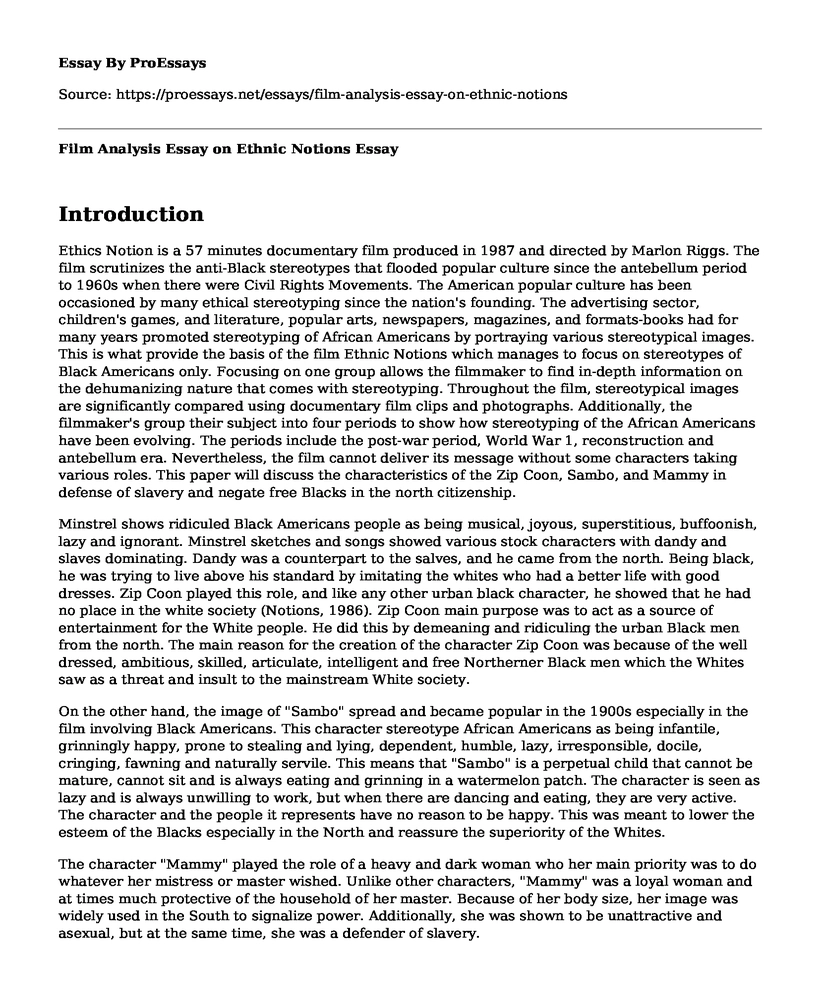Introduction
Ethics Notion is a 57 minutes documentary film produced in 1987 and directed by Marlon Riggs. The film scrutinizes the anti-Black stereotypes that flooded popular culture since the antebellum period to 1960s when there were Civil Rights Movements. The American popular culture has been occasioned by many ethical stereotyping since the nation's founding. The advertising sector, children's games, and literature, popular arts, newspapers, magazines, and formats-books had for many years promoted stereotyping of African Americans by portraying various stereotypical images. This is what provide the basis of the film Ethnic Notions which manages to focus on stereotypes of Black Americans only. Focusing on one group allows the filmmaker to find in-depth information on the dehumanizing nature that comes with stereotyping. Throughout the film, stereotypical images are significantly compared using documentary film clips and photographs. Additionally, the filmmaker's group their subject into four periods to show how stereotyping of the African Americans have been evolving. The periods include the post-war period, World War 1, reconstruction and antebellum era. Nevertheless, the film cannot deliver its message without some characters taking various roles. This paper will discuss the characteristics of the Zip Coon, Sambo, and Mammy in defense of slavery and negate free Blacks in the north citizenship.
Minstrel shows ridiculed Black Americans people as being musical, joyous, superstitious, buffoonish, lazy and ignorant. Minstrel sketches and songs showed various stock characters with dandy and slaves dominating. Dandy was a counterpart to the salves, and he came from the north. Being black, he was trying to live above his standard by imitating the whites who had a better life with good dresses. Zip Coon played this role, and like any other urban black character, he showed that he had no place in the white society (Notions, 1986). Zip Coon main purpose was to act as a source of entertainment for the White people. He did this by demeaning and ridiculing the urban Black men from the north. The main reason for the creation of the character Zip Coon was because of the well dressed, ambitious, skilled, articulate, intelligent and free Northerner Black men which the Whites saw as a threat and insult to the mainstream White society.
On the other hand, the image of "Sambo" spread and became popular in the 1900s especially in the film involving Black Americans. This character stereotype African Americans as being infantile, grinningly happy, prone to stealing and lying, dependent, humble, lazy, irresponsible, docile, cringing, fawning and naturally servile. This means that "Sambo" is a perpetual child that cannot be mature, cannot sit and is always eating and grinning in a watermelon patch. The character is seen as lazy and is always unwilling to work, but when there are dancing and eating, they are very active. The character and the people it represents have no reason to be happy. This was meant to lower the esteem of the Blacks especially in the North and reassure the superiority of the Whites.
The character "Mammy" played the role of a heavy and dark woman who her main priority was to do whatever her mistress or master wished. Unlike other characters, "Mammy" was a loyal woman and at times much protective of the household of her master. Because of her body size, her image was widely used in the South to signalize power. Additionally, she was shown to be unattractive and asexual, but at the same time, she was a defender of slavery.
References
Notions, E. (1986). Marlon Riggs. California Newsreel.
Cite this page
Film Analysis Essay on Ethnic Notions. (2022, May 16). Retrieved from https://proessays.net/essays/film-analysis-essay-on-ethnic-notions
If you are the original author of this essay and no longer wish to have it published on the ProEssays website, please click below to request its removal:
- Comparison of the Big Sleep Book to Movie
- Cultures, Leadership, and Decision-Making of Ethical Issues - Juno Movie Review
- Melinda's Crisis and Theories Explaining It in Acrimony Movie Paper Example
- Documentary Analysis Essay on Park Avenue: Money, Power and the American Dream
- Effect of Architecture in Reducing Crimes - Research Paper
- Movie Analysis Essay on Life of Pi: A Journey of Belief, Discovery and Devotion
- Essay Sample on Social Media: Connecting People and Building Relationships







